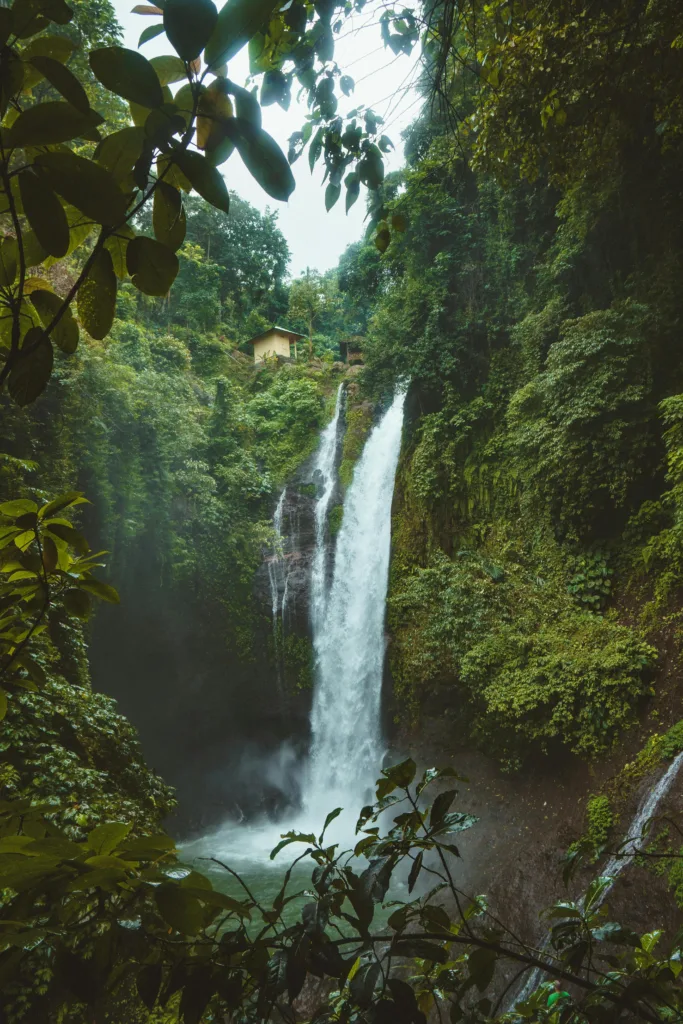Bali is an enchanting island paradise that offers something magical year-round. This is your “sign” that you must visit Bali!
Whether you’re drawn to its sun-kissed beaches, vibrant culture, or lush landscapes, Bali is a dream destination for travelers.
But timing your trip can make all the difference in experiencing Bali’s true essence.
Let’s dive into why Bali should be on your travel list and how to plan your visit based on its unique seasons.
Why Should You Visit Bali?
Bali is a tropical haven that seamlessly blends natural beauty with cultural richness.
With its crystal-clear waters, volcanic mountains, and terraced rice fields, the island’s landscapes are nothing short of breathtaking.
Add to that the warmth of Balinese hospitality and the vibrancy of their traditions, and you have a destination that captivates all your senses.
What makes us scream “Visit Bali” even more special is its diverse offerings for every kind of traveler.

Adventure seekers can surf world-class waves or hike Mount Batur at sunrise, while wellness enthusiasts can indulge in yoga retreats and spa treatments. Food lovers will revel in Bali’s culinary scene, from authentic street food to fine dining experiences.
A visit to Bali is not just a vacation—it’s an experience that feeds the soul.
With its spiritual roots, from ancient temples to serene meditation spots, Bali leaves a lasting impression. No matter what brings you here, this island promises unforgettable memories.
And another lovely, budget-friendly paradise that you need to visit after your Bali trip is definitely Thailand.
Seasonal Breakdown: When Is the Best Time to Visit Bali?
Bali, with its tropical climate, is a year-round destination, but the island’s charm shifts dramatically between the dry season and the wet season. To choose the perfect time for your trip, it’s important to understand how each season impacts weather, activities, and travel costs.
Dry Season (April to October): Paradise at Its Peak
The dry season is Bali’s most popular period, with warm, sunny days and low humidity. Temperatures typically range between 27–32°C (81–90°F), with very little rainfall, making it ideal for outdoor adventures and beach activities.
- Best Activities: Surfing enthusiasts flock to Bali during the dry season for the island’s world-class waves, especially at Uluwatu, Padang Padang, and Kuta Beach. Hiking is also at its peak, with clear skies providing perfect conditions for trekking Mount Batur at sunrise or exploring Bali’s less-visited mountains in Munduk. Divers and snorkelers will find the best underwater visibility at Nusa Penida and Tulamben, where vibrant coral reefs come alive.
- Cultural Highlights: This season coincides with numerous Balinese festivals like Galungan and Kuningan, where travelers can witness traditional dances, colorful offerings, and temple ceremonies. It’s also a great time to explore outdoor markets like Ubud Art Market or attend outdoor yoga retreats.
- What to Consider: June, July, and August are peak months, meaning larger crowds at popular attractions like the Tegallalang Rice Terraces and Tanah Lot Temple. Accommodation prices rise, and bookings for activities and tours should be made well in advance.
Wet Season (November to March): A Quieter, Lush Escape
The wet season brings frequent rains, high humidity, and temperatures similar to the dry season. While some travelers shy away from Bali during these months, others embrace the quieter atmosphere and vibrant greenery that the rains bring.
- Rain Patterns: Rainfall often comes in short, heavy bursts, usually in the late afternoon or evening. Mornings are typically clear, allowing for sightseeing before the rain begins.
- Best Activities: While beaches may not be at their best, the wet season is perfect for indoor experiences like spa days, Balinese cooking classes, or temple visits. Iconic sites like Tirta Empul and Besakih Temple become more serene, with fewer crowds. For nature lovers, the rainy season transforms Bali’s rice terraces and jungles into lush, vivid landscapes—a photographer’s dream. Waterfalls such as Tegenungan and Sekumpul flow more dramatically during this season, making them a must-visit.
- What to Consider: Humidity can make outdoor activities less comfortable, and some roads and trails may become muddy or slippery. However, this season offers a significant advantage: budget-friendly travel. Flights, accommodations, and tour prices drop, making Bali an excellent choice for off-season travelers.
Shoulder Seasons (March and October): The Perfect Balance
March and October are transitional months, offering a blend of the best features of both seasons. Rainfall is minimal, and temperatures remain comfortably warm. These months are often overlooked, making them a hidden gem for savvy travelers.
- Why Choose Shoulder Seasons? Travelers visiting during these months enjoy smaller crowds, as they fall outside Bali’s peak tourist season. Outdoor activities like hiking and diving are still enjoyable, and cultural attractions like temples and traditional villages are more accessible.
- Budget and Accessibility: While not as cheap as the wet season, shoulder seasons still offer moderately priced accommodations and airfare. For those looking to explore Bali’s famous attractions without the crowds or high costs, March and October provide the ideal window.
Unique Seasonal Highlights
- Surfing Seasons:
- Dry Season (April–October): The west coast of Bali offers the best waves for experienced surfers. Beaches like Uluwatu and Canggu are hotspots during this time.
- Wet Season (November–March): The east coast, including beaches like Nusa Dua and Sanur, becomes a haven for surfers due to offshore winds.
- Festivals to Watch:
- Nyepi (March): Bali’s Day of Silence is a unique cultural experience, where the entire island comes to a halt for introspection and rest.
- Bali Arts Festival (June–July): A month-long celebration showcasing Balinese dance, music, and art.
- Wildlife Spotting:
- The dry season is ideal for spotting dolphins off the coast of Lovina or diving with manta rays around Nusa Penida.
Seasonal Tips for your Visit Bali trip
Shoulder Season Tips: Take advantage of the quieter atmosphere to visit popular attractions early in the day, and seek out special discounts on tours or experiences.
Dry Season Tips: Book accommodations early and pack sunscreen, light clothing, and a reusable water bottle to stay hydrated under the Bali sun.
Wet Season Tips: Bring waterproof gear like a rain jacket or an umbrella, and plan flexible itineraries to accommodate sudden rain showers.
Holiday Periods and Festivals
Holiday seasons like Christmas and New Year’s see an influx of international tourists. If you’re visiting during these times, expect higher prices and bustling beaches. However, the festive atmosphere, complete with fireworks and beach parties, adds a unique vibe to the island.
Another highlight is Nyepi, Bali’s Day of Silence, typically held in March. It’s a day of reflection and tranquility, where the entire island comes to a standstill. Experiencing Nyepi can provide a deeper understanding of Balinese culture and spirituality.
Hidden Gems that you must see on your visit Bali trip
Bali is much more than its famous beaches and temples. Hidden gems like Sidemen Valley offer a serene escape from the crowds, with stunning landscapes and authentic village life. You can explore lush rice paddies and interact with locals who will welcome you with open arms.

Another must-see is the Tukad Cepung Waterfall, a magical spot where sunlight filters through the rocks, creating an ethereal glow. It’s an off-the-beaten-path destination perfect for adventure and photography enthusiasts. Arrive early to avoid the few visitors who make their way here.
If you’re a beach lover, skip the crowded Kuta Beach and head to Amed or Padang Padang Beach. These quieter spots boast crystal-clear waters and vibrant coral reefs, making them ideal for snorkeling and diving. Exploring these hidden gems will reveal a side of Bali that many tourists miss.
Things to Avoid on Your Visit Bali Trip
While Bali is a welcoming destination, there are a few things to keep in mind. Avoid drinking tap water as it can lead to health issues; stick to bottled or filtered water instead. Similarly, be cautious about street food from unhygienic stalls, especially if you have a sensitive stomach.
Another pitfall to avoid is over-packing your itinerary. Bali has so much to offer that it’s tempting to cram everything into one trip. Instead, focus on a few key activities and leave time to relax and soak in the island’s laid-back vibe.
Lastly, steer clear of unlicensed tour operators. While their prices may seem attractive, the quality and safety of their services can be questionable. Research thoroughly and book through reputable providers to ensure a hassle-free experience.
Bali’s Budget-Friendly Options
Traveling to Bali doesn’t have to break the bank. Affordable homestays and guesthouses provide comfortable accommodations without the hefty price tag. Many even offer complimentary breakfasts and a local touch that enhances your experience.
When it comes to food, Bali’s warungs (local eateries) serve delicious meals at a fraction of the cost of restaurants. Savor dishes like Nasi Goreng and Satay while supporting local businesses. Transportation is also budget-friendly, with scooter rentals and ride-hailing apps like Grab making it easy to get around.
For activities, consider exploring Bali’s natural attractions like waterfalls and rice terraces, which often have low or no entrance fees. With a little planning, you can enjoy the island’s beauty and culture without overspending.
How to Pack When You’re On Your Way to Visit Bali
Packing smartly for Bali can make your trip more comfortable and enjoyable. Lightweight, breathable clothing is essential due to the tropical climate, along with comfortable footwear for walking and exploring. Don’t forget to pack swimwear, as Bali’s beaches and pools are irresistible.
For temple visits, bring a sarong and a modest outfit to respect local customs. Sun protection items like sunscreen, sunglasses, and a hat are crucial for outdoor activities. Additionally, a reusable water bottle can help you stay hydrated while reducing plastic waste.

Lastly, consider packing insect repellent to ward off mosquitoes, especially if you’re visiting during the wet season. With the right essentials in your luggage, you’ll be ready to embrace all that Bali has to offer.
Must-Try Balinese Experiences
Bali is brimming with unique experiences that make your trip unforgettable. Attending a traditional Kecak dance performance at Uluwatu Temple offers a mesmerizing glimpse into Balinese culture against the backdrop of a stunning sunset. Furthermore, for adventure seekers, white-water rafting on the Ayung River is an exhilarating way to explore the island’s natural beauty.
Food lovers will enjoy sampling authentic Balinese cuisine, from Babi Guling (suckling pig) to Satay Lilit (minced fish satay). A visit to a local market, like Ubud Market, is perfect for discovering local flavors and souvenirs. These experiences showcase the diverse and vibrant spirit of Bali.
Another must-try experience is staying in a traditional Balinese villa or eco-lodge. These accommodations blend seamlessly with nature and often feature private pools and open-air living spaces. They provide an intimate and luxurious way to experience Bali’s charm.
FAQ
Q: What is the best month to visit Bali?
A: The best months are April, May, and September for pleasant weather and fewer crowds.
Q: Do I need a visa to visit Bali?
A: Many nationalities can enter Bali visa-free for up to 30 days. Check the latest regulations before your trip.
Q: Is Bali family-friendly?
A: Absolutely! Bali offers plenty of activities for families, from water parks to cultural tours.
Q: What currency is used in Bali?
A: The currency in Bali is the Indonesian Rupiah (IDR). Ensure you exchange money at authorized counters.
Q: Are credit cards widely accepted?
A: While larger establishments accept credit cards, carry cash for small shops and warungs.
We hope this guide inspires you to plan your dream trip to Bali. With its stunning landscapes, vibrant culture, and warm hospitality, Bali is truly a destination like no other. Happy travels, and don’t forget to share your Bali adventures with us! And if you’re looking for other paradise locations to visit, we recommend the Northern Lights – we know you’ll love it!
— Vick & Ellie





